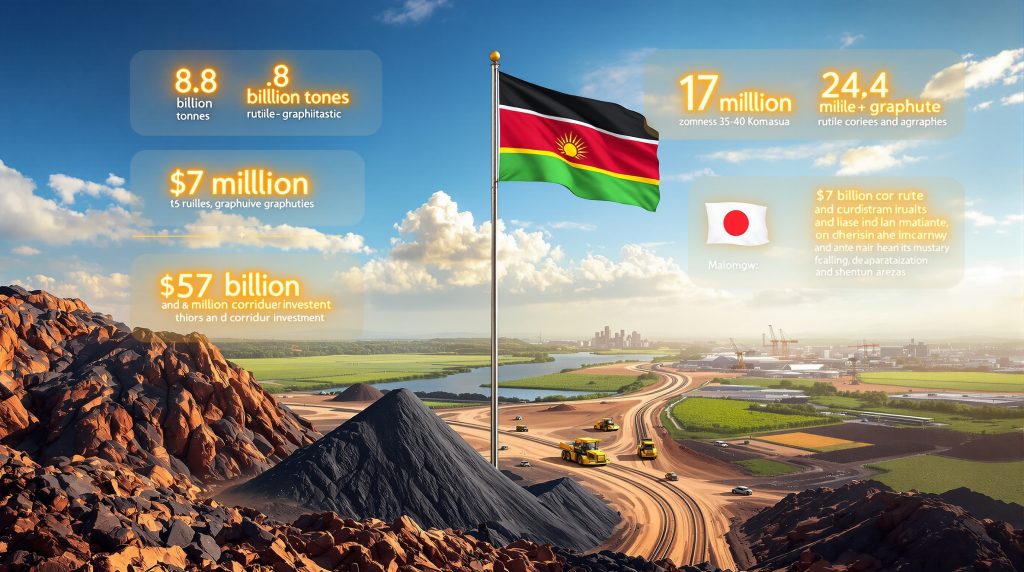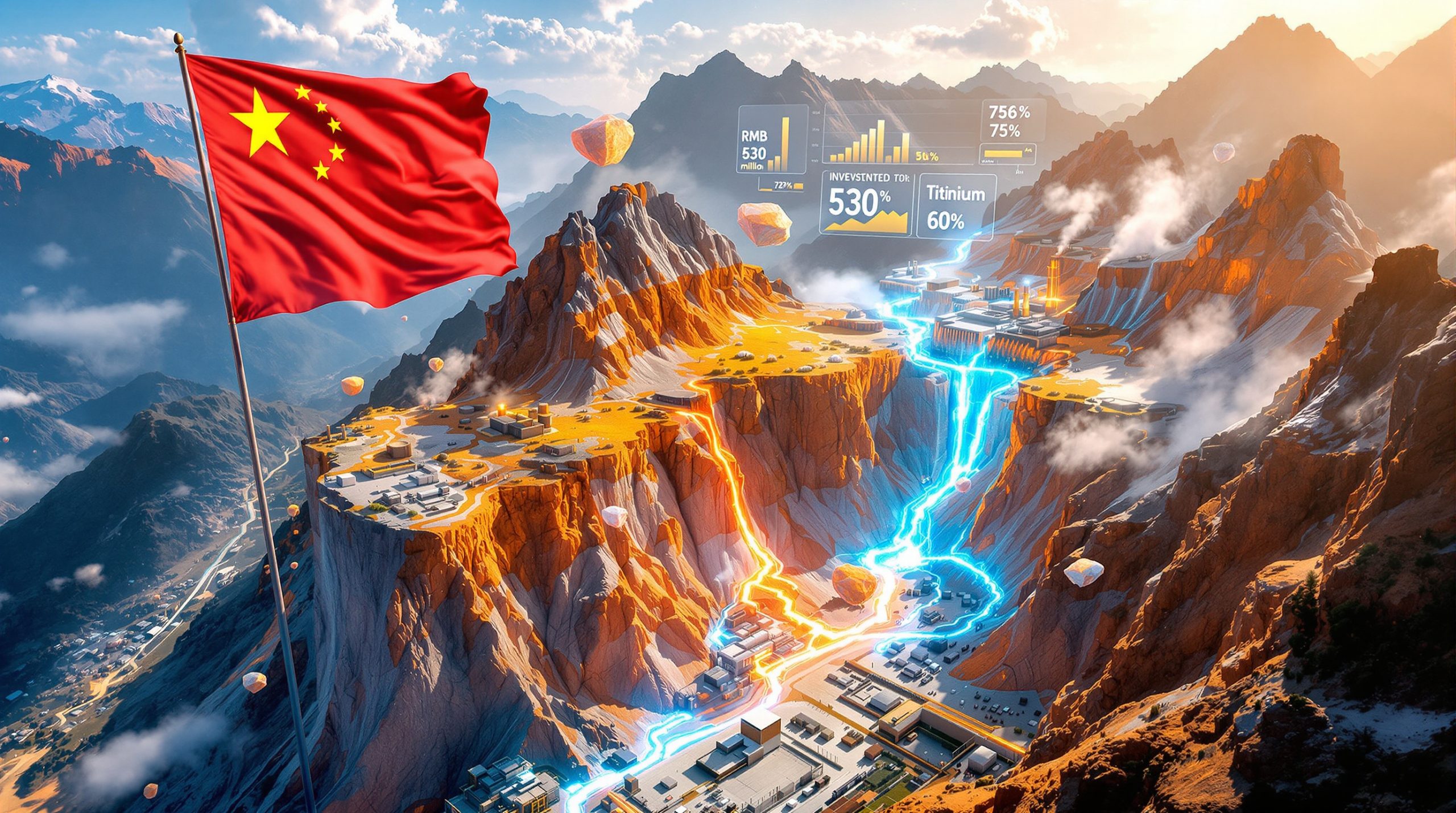Understanding Sovereign Metals' Dual-Commodity Strategy in Malawi
The Sovereign Metals Kasiya Rutile-Graphite Project represents a transformative development in the global critical minerals landscape. Located strategically in central Malawi, this dual-commodity operation positions itself to become a cornerstone of Western supply chain diversification efforts. Furthermore, this project directly addresses the growing need for critical minerals energy security in an increasingly complex geopolitical environment.
Project Location and Strategic Positioning
Positioned approximately 35 kilometers from Lilongwe, Malawi's capital city, the Kasiya project enjoys exceptional access to established infrastructure networks. This proximity to the political and economic center of Malawi provides significant advantages in terms of regulatory engagement, skilled workforce availability, and logistical coordination.
The project's location along the Nacala Corridor creates direct access to deep-water port facilities, reducing transportation costs and delivery times to international markets. Malawi's stable political environment and supportive mining framework provide additional security for long-term operations, particularly important given the 25-year projected mine life.
Mineral Resource Scale and Global Significance
The scale of the Kasiya deposit defies conventional industry standards. With resource estimates indicating 1.8 billion tonnes containing 17.9 million tonnes of rutile and 24.4 million tonnes of graphite, the project ranks as the world's largest natural rutile deposit and second-largest flake graphite deposit globally.
To contextualize these figures, the combined value equivalent approaches that of major precious metal deposits, yet the minerals serve critical roles in modern technology and defense applications. The rutile component alone represents decades of global supply, while the graphite resources position Kasiya as a potential game-changer in battery supply chains. Additionally, this project exemplifies the mineral beneficiation opportunities that exist across Africa.
How Does Japan's $7 Billion Corridor Investment Transform Kasiya's Economics?
The Japanese government's infrastructure commitment represents one of the most significant foreign development investments in African transport networks in recent years. This initiative directly addresses one of the primary challenges facing African mining projects: reliable, cost-effective access to international markets.
Nacala Logistics Corridor Enhancement Program
Japan's comprehensive approach combines $5.5 billion through the African Development Bank partnership with an additional $1.5 billion in public-private investment channeled through its development agency. The program targets capacity expansion, infrastructure resilience upgrades, and supply chain optimization specifically for critical minerals.
The enhancement program addresses historical bottlenecks that have constrained mineral exports from the region. By modernising rail systems, expanding port capacity, and improving cargo handling efficiency, the initiative creates a foundation for large-scale mining operations to reach global markets competitively. This strategic investment aligns with global initiatives to establish a critical minerals strategic reserve for Western economies.
Transportation Cost Advantages for Kasiya
Sovereign Metals plans to construct a 6-kilometre rail spur connecting its proposed processing facilities directly to the enhanced corridor infrastructure. This direct connection eliminates multiple handling stages and reduces transportation costs significantly compared to alternative routing options.
The improved infrastructure creates competitive advantages through:
- Reduced logistics costs per tonne
- Enhanced cargo handling capacity
- Improved delivery schedule reliability
- Lower risk of transport-related delays
| Transport Element | Current Capacity | Enhanced Capacity | Impact for Kasiya |
|---|---|---|---|
| Rail Infrastructure | Limited bulk handling | Modernised high-capacity systems | Direct spur connection reduces costs |
| Port Facilities | Basic cargo handling | Expanded throughput capacity | Faster vessel loading/unloading |
| Regional Connectivity | Standard infrastructure | Upgraded resilience systems | Reduced weather-related disruptions |
What Technical Innovations Make Kasiya's Mining Approach Unique?
The Kasiya project employs innovative mining methodologies that differentiate it from conventional operations while reducing environmental impact and operational complexity. These innovations represent part of the broader mining industry innovation trends reshaping the sector.
Hydro-Mining Technology Implementation
The project's design eliminates traditional mining processes including drilling, blasting, crushing, or milling. This approach reduces both capital expenditure and operational complexity while minimising environmental disruption. The large-scale dry mining operation utilises specialised equipment from established suppliers including Caterpillar, Komatsu, Liebherr, Hitachi, and Volvo.
Equipment selection focuses on proven technologies adapted for the specific geological conditions at Kasiya. The 25-year mine life operational planning incorporates equipment lifecycle management, maintenance scheduling, and replacement strategies to ensure consistent production capacity.
Geotechnical Investigation Results
Comprehensive subsurface analysis involving over 400 individual tests has confirmed favourable geological conditions consistent with regional geology patterns. The data indicates opportunities for standardised foundation designs, potentially reducing engineering complexity and associated costs.
Key findings from the geotechnical programme include:
- Stable subsurface conditions across key infrastructure locations
- Consistent geological characteristics enabling standardised designs
- Reduced foundation complexity compared to initial assessments
- Lower engineering risk factors for major infrastructure components
Progressive Rehabilitation Success Metrics
The rehabilitation pilot programme demonstrates the viability of progressive land restoration alongside mining operations. Results show 5.2 tonnes per hectare maize yields, representing a 500% improvement over local farming averages. This success demonstrates the importance of mine reclamation innovation in modern mining operations.
The programme involved 28 local farmers and incorporated advanced techniques including:
- Soil nutrient enhancement programmes
- Biochar application methods
- Intercropping with bamboo and legumes
- Water management optimisation
These results validate the project's environmental, social, and governance credentials while demonstrating potential for enhanced agricultural productivity in post-mining areas.
How Do Recent Market Developments Boost Kasiya's Commercial Prospects?
Global market dynamics have shifted significantly in favour of non-Chinese mineral sources, creating enhanced commercial opportunities for projects like Kasiya.
US Anti-Dumping Duties Impact on Graphite Markets
The US Commerce Department's decision to impose 93.5% anti-dumping duties on Chinese graphite imports fundamentally reshapes global supply economics. This policy creates substantial cost advantages for alternative sources, particularly those demonstrating reliable supply capacity and quality standards.
Kasiya's positioning as the world's largest and lowest-cost non-Chinese graphite producer becomes increasingly valuable in this environment. With an estimated incremental production cost of $241 per tonne, the project offers significant economic advantages over traditional sources while meeting Western supply security objectives.
Rutile Market Dynamics and Titanium Applications
Rutile demand continues expanding across multiple high-value sectors:
- Aerospace and defence industries requiring premium-grade titanium
- Medical device manufacturing demanding biocompatible materials
- Consumer goods applications seeking durable, lightweight components
- Industrial processes requiring corrosion-resistant materials
The strategic importance of rutile in defence applications creates additional supply security premiums for Western-aligned sources, particularly given geopolitical tensions affecting traditional supply chains.
Battery-Grade Graphite Performance Metrics
Optimisation testing by Prographite GmbH confirms Kasiya graphite achieves premium performance metrics for coated spherical purified graphite anode applications. Test results demonstrate discharge capacity exceeding 360 mAh/g and first-cycle efficiency above 94%.
These performance characteristics position Kasiya graphite competitively for high-performance battery applications, particularly in electric vehicle and energy storage markets where efficiency and capacity are critical factors.
What Are the Key Development Milestones and Timeline Expectations?
The project advancement follows a structured timeline designed to optimise technical design while managing development risks effectively.
Definitive Feasibility Study Progress
The definitive feasibility study (DFS) targets completion in Q1 2026 under supervision of the Sovereign-Rio Tinto Technical Committee. This collaborative approach leverages Rio Tinto's technical expertise while maintaining Sovereign Metals' project control.
Current DFS components include:
- Mine fleet design optimisation for large-scale operations
- Process plant engineering incorporating proven technologies
- Logistics infrastructure planning aligned with corridor enhancements
- Environmental impact assessment and mitigation strategies
Capital Investment and Financing Structure
Initial capital expenditure estimates indicate $597 million for project development, structured across a two-stage development approach spanning the 25-year operational period. This phased approach allows for operational learning and capacity optimisation while managing initial capital requirements.
Financing considerations include:
- Strategic investment backing from Rio Tinto partnership
- Government development finance opportunities through allied nations
- Export credit facilities supporting infrastructure development
- Off-take agreement prepayments from end-user partners
Regulatory and Environmental Compliance
The project operates within Malawi's export processing framework, ensuring compliance with national beneficiation requirements. All rutile and graphite production will undergo in-country processing and beneficiation to create high-grade products suitable for international markets.
Environmental compliance strategies incorporate:
- Progressive rehabilitation methodology proven in pilot programmes
- Community development initiatives supporting local economic growth
- Water resource management systems protecting regional supplies
- Biodiversity conservation measures aligned with international standards
Why Does Kasiya Represent a Strategic Asset for Critical Minerals Security?
The Sovereign Metals Kasiya Rutile-Graphite Project addresses fundamental strategic concerns regarding critical mineral supply security for Western economies and their allies.
Global Supply Chain Diversification Benefits
Current global supply chains for both rutile and graphite demonstrate concerning concentration in Chinese sources. Kasiya offers substantial diversification benefits through:
- Reduced dependency on geopolitically sensitive supply sources
- Enhanced supply security for technology and defence sectors
- Improved pricing stability through competitive alternative sources
- Strategic reserve capacity supporting allied nation requirements
ESG Credentials and Sustainability Advantages
The project's environmental, social, and governance profile provides significant advantages in current market conditions where institutional investors increasingly prioritise sustainability metrics.
Environmental advantages include:
- Renewable energy utilisation from Malawi's grid system
- Low carbon footprint operational design
- Progressive land rehabilitation methodology
- Minimal water consumption relative to conventional mining
Social benefits encompass:
- Community engagement programmes involving local stakeholders
- Local employment creation supporting regional development
- Agricultural enhancement initiatives improving food security
- Skills development programmes building local capacity
Investment and Offtake Opportunity Assessment
The project attracts increasing interest from US and allied nation buyers seeking reliable critical mineral sources. Long-term supply contract negotiations position Kasiya to capture premium pricing while providing supply security to strategic partners.
Strategic partnership opportunities include:
- Government-to-government agreements supporting supply security
- Technology sector partnerships in battery and electronics industries
- Defence contractor relationships for strategic material requirements
- Financial institution backing aligned with sustainability objectives
What Challenges and Risk Factors Should Investors Consider?
While the Kasiya project demonstrates exceptional potential, several risk factors require careful consideration and management strategies.
Infrastructure Development Dependencies
Despite Japan's substantial corridor investment, the project remains dependent on successful infrastructure development execution. Potential challenges include:
- Construction timeline delays affecting project scheduling
- Regional transport network reliability during development phases
- Port capacity constraints limiting export capabilities
- Power supply stability and grid connection requirements
Market Price Volatility and Demand Fluctuations
Commodity markets demonstrate inherent volatility that affects project economics:
- Commodity price cycles influencing revenue projections
- Battery technology evolution potentially affecting graphite specifications
- Alternative material development creating competitive pressures
- Global economic conditions impacting demand patterns
Operational and Technical Risk Management
Large-scale mining operations face various operational challenges:
- Hydro-mining technology scalability from pilot to production scale
- Equipment availability and maintenance logistics in remote locations
- Skilled workforce development requirements in rural Malawi
- Environmental compliance monitoring and reporting systems
How Does Kasiya Compare to Other Major Critical Minerals Projects?
The Sovereign Metals Kasiya Rutile-Graphite Project demonstrates several competitive advantages when benchmarked against comparable critical minerals developments globally.
Production Scale and Resource Quality Benchmarking
Kasiya's resource scale positions it uniquely in global rankings:
- Largest natural rutile deposit globally by contained metal
- Second-largest flake graphite deposit worldwide
- High-grade concentrations reducing processing complexity
- Long-life resource base supporting multi-decade operations
Quality metrics demonstrate competitive advantages in both commodity streams, with rutile grades suitable for premium titanium applications and graphite specifications meeting battery-grade requirements.
Development Timeline and Capital Efficiency
Compared to peer projects, Kasiya demonstrates several efficiency advantages:
| Comparison Factor | Kasiya Advantage | Industry Average | Kasiya Benefit |
|---|---|---|---|
| Capital Intensity | $597M for dual commodity | $400-800M single commodity | Diversified revenue streams |
| Infrastructure Access | 6km rail spur required | 50-200km transport development | Lower infrastructure investment |
| Processing Complexity | No crushing/milling required | Traditional beneficiation | Reduced operational costs |
| Development Timeline | DFS completion Q1 2026 | 2-4 years typical | Accelerated path to production |
What Does the Future Hold for Sovereign Metals and the Kasiya Project?
The Sovereign Metals Kasiya Rutile-Graphite Project stands positioned to capitalise on converging market trends and strategic developments that favour critical mineral supply diversification.
Near-Term Catalysts and Milestones
Several key developments will drive project advancement through 2026:
- DFS completion and results announcement in Q1 2026
- Off-take agreement negotiations with Western buyers
- Final investment decision following feasibility confirmation
- Construction commencement planning and contractor selection
Each milestone represents potential value inflection points while reducing project risk through demonstrated progress and market validation. For more detailed information about the project's development, the Kasiya Project overview provides comprehensive technical specifications.
Long-Term Production and Market Impact
Once operational, Kasiya projects to achieve significant market position:
- Annual rutile production capacity targeting substantial global market share
- Graphite output volumes positioning as largest non-Chinese producer
- Supply chain integration with technology and defence sectors
- Strategic partnership development supporting long-term growth
Regional Development and Economic Impact
The project's broader implications extend beyond direct mining operations:
- Malawi economic contribution through export revenues and local spending
- Employment creation supporting thousands of direct and indirect positions
- Infrastructure development benefits improving regional connectivity
- Mining sector catalyst attracting additional investment to the region
Recent developments in mining fleet acquisition demonstrate the project's progression towards production readiness.
Investment Considerations: While the Kasiya project demonstrates exceptional potential across multiple dimensions, investors should carefully evaluate commodity price volatility, infrastructure development risks, and operational scaling challenges. The project's dual-commodity nature provides revenue diversification benefits, but also requires expertise across two distinct market sectors.
The convergence of geopolitical supply security concerns, technological demand growth, and infrastructure development creates a favourable environment for the Sovereign Metals Kasiya Rutile-Graphite Project. Success will depend on execution excellence across technical, commercial, and operational dimensions while maintaining strong stakeholder relationships in Malawi and international markets.
Further Exploration: Investors seeking additional insights into critical minerals sector developments and African mining opportunities can explore industry publications and research organisations that provide comprehensive coverage of emerging projects and market dynamics in the region.
Ready to Invest in the Next Major Mineral Discovery?
Discovery Alert instantly alerts investors to significant ASX mineral discoveries using its proprietary Discovery IQ model, turning complex mineral data into actionable insights. Understand why historic discoveries can generate substantial returns by visiting Discovery Alert's dedicated discoveries page and begin your 30-day free trial today to position yourself ahead of the market.




